Minerals of Alabama
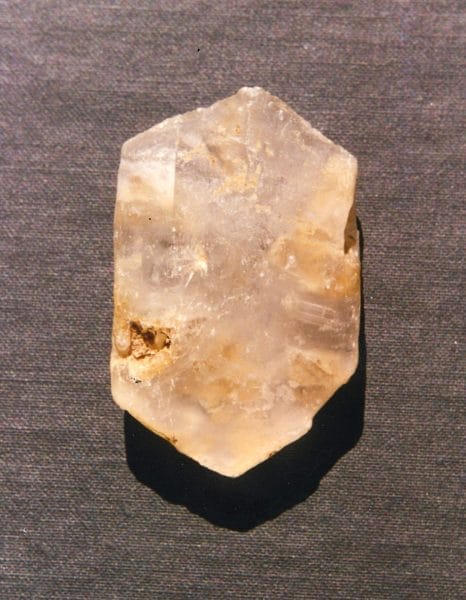 Gypsum
Alabama is home to a diverse and widespread variety of minerals, with more than 190 mineral species occurring in the state. These minerals have played a key role in the development of the state, beginning with the prehistoric period, when flint, mica, clay, and other rocks and minerals were used by Native Americans. The state’s rich stores of iron-bearing hematite provided the raw materials for Birmingham‘s rise as an industrial center in the late nineteenth and early twentieth century. In the latter half of the twentieth century Alabama was ranked annually in the top 20 among the states in value of minerals produced in the United States. Continued demand is expected for mineral resources, especially for those located near urban areas where the need for construction materials is greatest.
Gypsum
Alabama is home to a diverse and widespread variety of minerals, with more than 190 mineral species occurring in the state. These minerals have played a key role in the development of the state, beginning with the prehistoric period, when flint, mica, clay, and other rocks and minerals were used by Native Americans. The state’s rich stores of iron-bearing hematite provided the raw materials for Birmingham‘s rise as an industrial center in the late nineteenth and early twentieth century. In the latter half of the twentieth century Alabama was ranked annually in the top 20 among the states in value of minerals produced in the United States. Continued demand is expected for mineral resources, especially for those located near urban areas where the need for construction materials is greatest.
 Ore Crusher at Ruffner Mountain Nature Center
A mineral is defined as a naturally occurring inorganic solid having a specific and characteristic chemical composition and usually possessing a definite crystalline structure. Alabama’s mineral diversity relates to the rock types found in the state. A rock can be made of a single mineral or an aggregate of several minerals, and all rocks belong to one of three groups: igneous, sedimentary, and metamorphic. The diverse geologic makeup of the state is reflected in the large number of different mineral species found in Alabama. Most of the state is covered with sedimentary rocks, with exposures of igneous and metamorphic rocks being confined to the east-central part of the state. Alabama minerals vary from common rock-forming minerals such as clay, calcite, and quartz to precious metals such as gold.
Ore Crusher at Ruffner Mountain Nature Center
A mineral is defined as a naturally occurring inorganic solid having a specific and characteristic chemical composition and usually possessing a definite crystalline structure. Alabama’s mineral diversity relates to the rock types found in the state. A rock can be made of a single mineral or an aggregate of several minerals, and all rocks belong to one of three groups: igneous, sedimentary, and metamorphic. The diverse geologic makeup of the state is reflected in the large number of different mineral species found in Alabama. Most of the state is covered with sedimentary rocks, with exposures of igneous and metamorphic rocks being confined to the east-central part of the state. Alabama minerals vary from common rock-forming minerals such as clay, calcite, and quartz to precious metals such as gold.
Clays
The term “clay” usually refers to a finely textured mineral material, found in almost all soil types in the state, that is comprised of extremely small particles and is the most widespread and common group of silicate minerals. Clays are widely distributed, being found in every county in the state and in most of the state’s geological formations. Different kinds of clay mined in Alabama include bentonite, fireclay, common clay, shale, and kaolin. Clays are generally made up of hydrous aluminum silicates combined in varying proportions. When pulverized and mixed with water, clay forms a mass that can be molded and that hardens when heated to a high temperature, called firing. Clay was used widely by Native Americans for thousands of years to make pottery and other items, and the earliest commercial use of clay mineral deposits in Alabama was by British settlers in 1780 for making bricks, tiles, and pottery in Mobile. Historically, clay deposits along the eastern shore of Mobile Bay were some of the earliest locations of historic pottery operations in the state. More recently, clay has expanded its applications to innumerable industrial and commercial uses, including clay pipe, lightweight aggregate, and ceramics. It still retains its traditional importance in the manufacture of brick and tile, and Alabama clay still serves as the raw material for artisan potteries such as Miller’s Pottery in Brent in Bibb County.
Limestone and Chalk
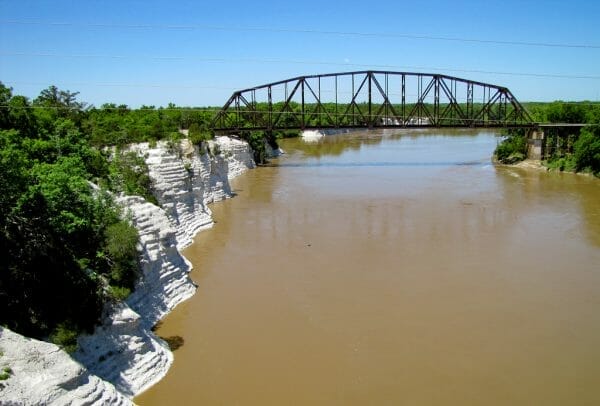 Chalk Deposits in Sumter County
Limestone is a sedimentary rock consisting principally of the mineral calcite (calcium carbonate) and is widely distributed in Alabama. The limestones of Alabama have a wide variety of chemical and physical properties and have been used for various purposes throughout human history in the region. Limestone is the source of the chert and flint used for projectile points in prehistoric times by Native Americans. One of the earliest uses of limestone in historic times was for common building stone and in the production of lime for iron manufacturing, notably in Shelby County. Limestone is currently used in various applications, including metallurgical flux, construction aggregate, building dimension stone, and soil conditioner to neutralize acidic content. Limestone also has many industrial uses, including the manufacture of glass, abrasives, cement, and lime. Chalk, a soft, extremely fine-textured variety of limestone, occurs in the Coastal Plain section of west-central Alabama, forming prominent bluffs along the Tombigbee River. The Demopolis Chalk of the Selma Group has been mined for use in the manufacture of Portland cement and agricultural soil conditioner since 1900 from the Spocari quarry near Demopolis.
Chalk Deposits in Sumter County
Limestone is a sedimentary rock consisting principally of the mineral calcite (calcium carbonate) and is widely distributed in Alabama. The limestones of Alabama have a wide variety of chemical and physical properties and have been used for various purposes throughout human history in the region. Limestone is the source of the chert and flint used for projectile points in prehistoric times by Native Americans. One of the earliest uses of limestone in historic times was for common building stone and in the production of lime for iron manufacturing, notably in Shelby County. Limestone is currently used in various applications, including metallurgical flux, construction aggregate, building dimension stone, and soil conditioner to neutralize acidic content. Limestone also has many industrial uses, including the manufacture of glass, abrasives, cement, and lime. Chalk, a soft, extremely fine-textured variety of limestone, occurs in the Coastal Plain section of west-central Alabama, forming prominent bluffs along the Tombigbee River. The Demopolis Chalk of the Selma Group has been mined for use in the manufacture of Portland cement and agricultural soil conditioner since 1900 from the Spocari quarry near Demopolis.
Salt
Salt deposits, composed of the mineral halite (sodium chloride), underlie much of southwest Alabama at depths that range from 400 feet to more than 18,000 feet. Salt brine seeps or natural springs in Washington and Clarke counties were used to produce salt for food preservation intermittently during the Civil War. Large-scale production of salt brine began in 1952 at McIntosh in Washington County for the manufacture of industrial alkaline chemicals.
Quartz
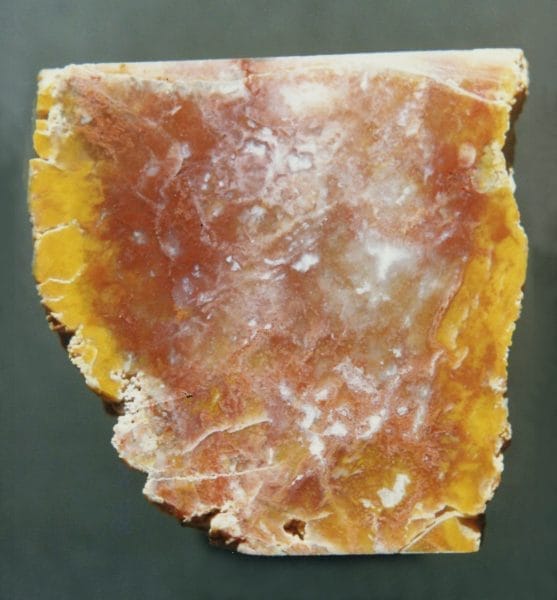 Agate Quartz
Quartz (silicon dioxide) is an important rock-forming mineral and is a prominent constituent of sand, gravel, sandstone, and several types of metamorphic and igneous rocks. Quartz is clear and colorless but can be brown, yellow, red, white, pink, and purple when impurities are present in it. Small quartz crystals may be found in cavities in limestone in the rocks of north Alabama, and large quartz crystals have been found associated with the coarse-grained rocks known as pegmatites, found in east Alabama. Quartz is an ideal abrasive material and is used in the manufacture of sandpaper, saws, and linings for tube-mills for grinding. Alabama’s quartz sand and gravel deposits are an abundant source of industrial raw materials for construction and in the manufacture of glass, ceramics, and clay refractories. The most extensive deposits occur in the Coastal Plain section in an area extending from Dallas County through Montgomery County and into Russell County. The Montgomery district, located in the Coastal Plain section of south-central Alabama, is the main source of sand and gravel in the state. These deposits occur principally in river alluvium and terrace flood plain deposits of the Alabama, Coosa, and Tallapoosa Rivers bordering Montgomery, Autauga, Lowndes, Elmore, and Macon Counties.
Agate Quartz
Quartz (silicon dioxide) is an important rock-forming mineral and is a prominent constituent of sand, gravel, sandstone, and several types of metamorphic and igneous rocks. Quartz is clear and colorless but can be brown, yellow, red, white, pink, and purple when impurities are present in it. Small quartz crystals may be found in cavities in limestone in the rocks of north Alabama, and large quartz crystals have been found associated with the coarse-grained rocks known as pegmatites, found in east Alabama. Quartz is an ideal abrasive material and is used in the manufacture of sandpaper, saws, and linings for tube-mills for grinding. Alabama’s quartz sand and gravel deposits are an abundant source of industrial raw materials for construction and in the manufacture of glass, ceramics, and clay refractories. The most extensive deposits occur in the Coastal Plain section in an area extending from Dallas County through Montgomery County and into Russell County. The Montgomery district, located in the Coastal Plain section of south-central Alabama, is the main source of sand and gravel in the state. These deposits occur principally in river alluvium and terrace flood plain deposits of the Alabama, Coosa, and Tallapoosa Rivers bordering Montgomery, Autauga, Lowndes, Elmore, and Macon Counties.
Copper
Copper occurs in Alabama as chalcopyrite (copper iron sulfide) and is found in association with massive sulfide deposits in Clay and Cleburne Counties. Exploration for copper began in the northern Alabama Piedmont in the 1850s near the towns of Pyriton and Millerville in Clay County and the Stone Hill mine in Cleburne County. Copper ore was mined at Stone Hill from 1874 to 1879 and shipped out of state for smelting.
Gold
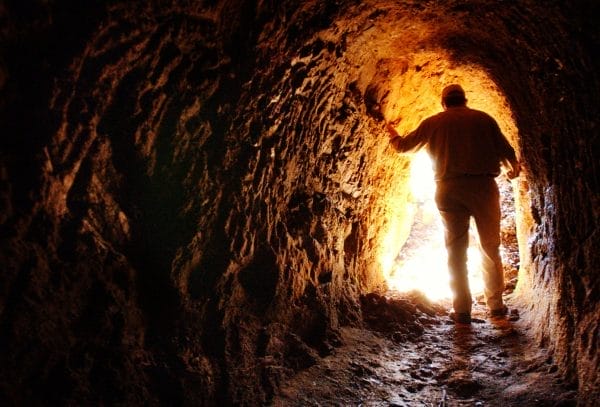 Goldville Mine
Gold, a native (meaning naturally occurring in its pure form) element and precious metal, was discovered in Alabama in the early 1830s and has been mined from a number of historic gold districts of the Piedmont region. The amount of gold extracted from the 1830s to 1930s equaled 49,000 troy ounces (a measurement for precious metals) of gold. Gold has been reported in Clay, Randolph, Cleburne, Talladega, Tallapoosa, Coosa, and Chilton Counties in more than 100 prospects and mines. Several towns, including Arbacoochee, Chulafinnee, and Goldville, were established during the gold rush of the 1830s but are now abandoned. The Hog Mountain mine, which operated between 1904 and 1914 and 1934 and 1937 in Tallapoosa County, was the most extensively developed gold mine in Alabama and is credited with a total production of about 24,000 troy ounces of gold. Gold mining ceased in Alabama during the late 1930s, although a few individuals continue to prospect on their own.
Goldville Mine
Gold, a native (meaning naturally occurring in its pure form) element and precious metal, was discovered in Alabama in the early 1830s and has been mined from a number of historic gold districts of the Piedmont region. The amount of gold extracted from the 1830s to 1930s equaled 49,000 troy ounces (a measurement for precious metals) of gold. Gold has been reported in Clay, Randolph, Cleburne, Talladega, Tallapoosa, Coosa, and Chilton Counties in more than 100 prospects and mines. Several towns, including Arbacoochee, Chulafinnee, and Goldville, were established during the gold rush of the 1830s but are now abandoned. The Hog Mountain mine, which operated between 1904 and 1914 and 1934 and 1937 in Tallapoosa County, was the most extensively developed gold mine in Alabama and is credited with a total production of about 24,000 troy ounces of gold. Gold mining ceased in Alabama during the late 1930s, although a few individuals continue to prospect on their own.
Graphite
The mineral graphite is the most common form of native pure carbon. In Alabama, graphite generally occurs as flakes dispersed within the metamorphic rocks of the Piedmont section in the east-central part of the state. The mineral is particularly abundant in Clay, Coosa, and southeastern Chilton Counties, and the graphite-rich rocks within these counties form one of the largest graphite deposits in the United States. Graphite is important in the manufacture of electrical products and high-temperature crucibles for the metals industry. Graphite is commonly used as a dry lubricant and also is mixed with clay to form the “lead” in pencils. Graphite mining reached its peak in Clay and Coosa Counties during World War I. Forty-three major mines and 30 processing plants were in operation during this period. In the 1950s, graphite mining began a decline as technological advances led to the development and production of artificial graphite and as imports of less expensive foreign graphite increased.
Iron Ore Minerals
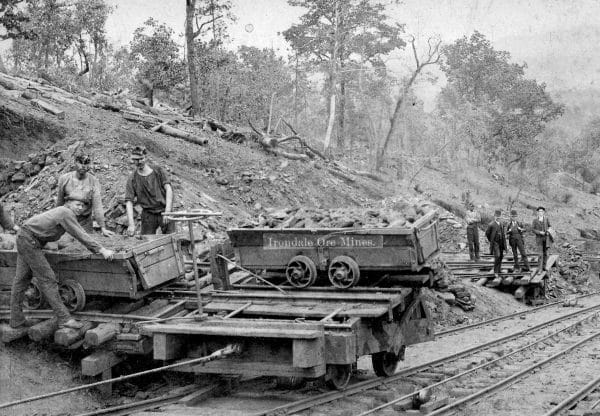 Irondale Ore Mine
Red iron ore from the Red Mountain Formation has been mined in Bibb, Blount, Cherokee, DeKalb, Etowah, Jefferson, and Tuscaloosa Counties. Brown iron ore has been mined in Barbour, Butler, Calhoun, Cherokee, Chilton, Colbert, Conecuh, Crenshaw, Franklin, Jefferson, Pike, Shelby, and Tuscaloosa Counties. Brown iron ore washing and screening factories were generally located near the open-pit mine and were moved as mining operations shifted from one mine to another. The emergence of the iron industry in Alabama during the early and mid-nineteenth century marked the beginning of the state’s industrial era. Early iron-making efforts made use of the local “brown iron ore” (the mineral limonite) and charcoal at massive stone furnaces such as those at Tannehill (1830), Polkville (1843), Shelby (1844), at Round Mountain (1852). The industry expanded dramatically with the discovery of red ore (hematite) at Red Mountain near Birmingham. Until the nineteenth century, iron-ore mining was one of the most important components of the state’s economy, but competition from imports, beginning in the mid-twentieth century, gradually eclipsed Alabama’s mining industry. In 1967, hematite was designated the official state mineral by the Alabama legislature.
Irondale Ore Mine
Red iron ore from the Red Mountain Formation has been mined in Bibb, Blount, Cherokee, DeKalb, Etowah, Jefferson, and Tuscaloosa Counties. Brown iron ore has been mined in Barbour, Butler, Calhoun, Cherokee, Chilton, Colbert, Conecuh, Crenshaw, Franklin, Jefferson, Pike, Shelby, and Tuscaloosa Counties. Brown iron ore washing and screening factories were generally located near the open-pit mine and were moved as mining operations shifted from one mine to another. The emergence of the iron industry in Alabama during the early and mid-nineteenth century marked the beginning of the state’s industrial era. Early iron-making efforts made use of the local “brown iron ore” (the mineral limonite) and charcoal at massive stone furnaces such as those at Tannehill (1830), Polkville (1843), Shelby (1844), at Round Mountain (1852). The industry expanded dramatically with the discovery of red ore (hematite) at Red Mountain near Birmingham. Until the nineteenth century, iron-ore mining was one of the most important components of the state’s economy, but competition from imports, beginning in the mid-twentieth century, gradually eclipsed Alabama’s mining industry. In 1967, hematite was designated the official state mineral by the Alabama legislature.
Galena
Galena (lead sulfide) and the closely related sphalerite (zinc sulfide) occur sporadically in limestones and dolomites in the Valley and Ridge section of Calhoun County. These minerals were mined for their lead content on a small scale in the county’s Angel district during the Civil War period.
Muscovite
Muscovite mica (hydrous potassium aluminum silicate) is found as sheets or “books” in the metamorphic and igneous rocks of the Piedmont. Mica-bearing rocks have been mined extensively in Randolph, Cleburne, Clay, Coosa, and Tallapoosa Counties. Commercial mining of muscovite sheet mica deposits in Alabama began in 1870 at the Pinetucky No. 1 mine in Randolph County. Scrap or flake mica is used by industry in dry-, wet-, or micronized-ground form for use in construction materials such as roofing, shingles, and wallboard.
Pyrite
Pyrite (iron disulfide), known popularly as fool’s gold, is a common mineral in the Piedmont and occurs in metamorphic, igneous, and sedimentary rocks. Pyrite deposits in the Hillabee Greenstone geologic formation in the vicinity of Pyriton, Clay County, were first mined in the 1850s by mining companies to produce sulphur acid and elemental sulfur. Production of pyrite for sulfur used in manufacturing chemicals continued intermittently until World War I, however, is no longer mined in the state.
Talc
Talc (hydrated magnesium silicate) occurs in association with metamorphosed dolomite near Winterboro, Talladega County. It also occurs in association with anthophyllite asbestos in altered mafic rocks in Chambers and Tallapoosa counties. Talc is used primarily in ceramics, cosmetics, paints, and construction materials.
Gemstones and Collectible Minerals
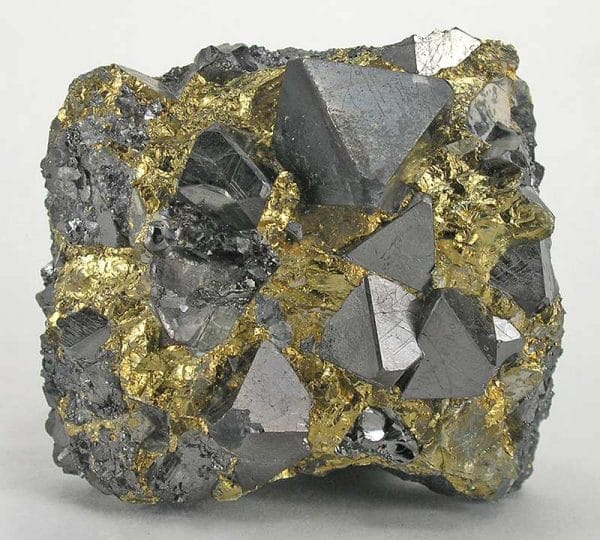 Magnetite
In addition to being useful, many of the minerals discussed above are of interest to collectors, but Alabama is home to a variety of gemstones and other specimen-quality minerals that are sought after just for their appearance and characteristics. These minerals include amphiboles, amethyst, andalusite, beryl (emerald), apatite, calcite, fluorite, gypsum, ilmenite, magnetite, monazite, niter, onyx, opal, quartz (agate), rutile, staurolite, tourmaline, turquoise, and wavellite. There are gem and mineral clubs in Huntsville and Montgomery.
Magnetite
In addition to being useful, many of the minerals discussed above are of interest to collectors, but Alabama is home to a variety of gemstones and other specimen-quality minerals that are sought after just for their appearance and characteristics. These minerals include amphiboles, amethyst, andalusite, beryl (emerald), apatite, calcite, fluorite, gypsum, ilmenite, magnetite, monazite, niter, onyx, opal, quartz (agate), rutile, staurolite, tourmaline, turquoise, and wavellite. There are gem and mineral clubs in Huntsville and Montgomery.
Further Reading
- Cook, R. B., and W. E. Smith. “Mineralogy of Alabama.” Alabama Geological Survey Bulletin 120. Tuscaloosa: Alabama Geological Survey, 1982.
- Dean, Lewis S. “Alabama Mineral Locality Index.” Rocks & Minerals (September/October 1995): 320-33.



